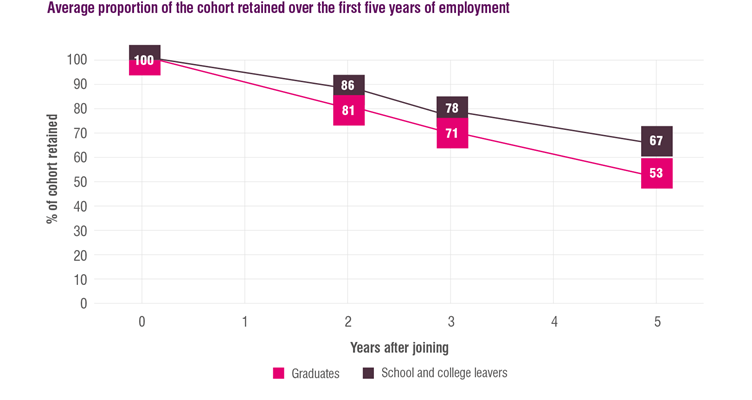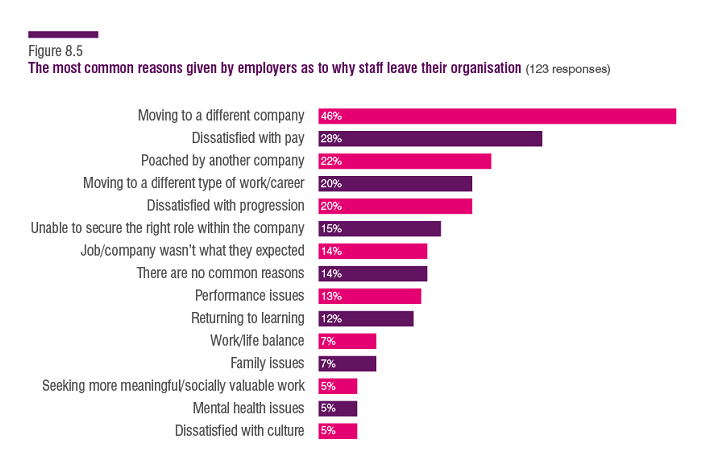ISE’s Tristram Hooley explores why young talent leaves organisations and how to better retain graduates and school leavers.
Student recruitment is an expensive business.
The typical ISE member will spend around £3,000 for every student that it hires. It will then invest a further £3,000 in training and developing each one of these hires.
When you add that onto the average starting salaries of around £30,000 a year for graduates and £20,000 a year for school leavers this represents a substantial investment. Making this kind of investment makes no sense if students up and leave after a few months?
How flighty are students?
You’ve probably heard a range of spurious statistics about how many jobs people are supposed to have during their lifetime. These kinds of figures are variously used to demonstrate that the labour market is becoming more dynamic and that employees’ attachment to organisations is falling.
There is some truth in both of these ideas, but also a fair degree of myth-making. The job for life was never a reality for most people and employees have always moved on to greener pastures when they could. But there are clearly some new factors that are driving more job changing, not least the pandemic.
Despite the moral panic about the increasing rapidity of job changing, the evidence from ISE’s Student Development Survey is that students are actually amazingly loyal. The figure below shows s the average proportion of graduates and school and college leavers who are retained during the first five years of employment.

The fact that after five years the average ISE member still retains more than half of their graduates and more than two-thirds of their school and college leavers demonstrates that they are managing to find and keep students who fit into their organisation well. But, it still shows substantial numbers of hires leaving firms and it is worth thinking about why this is.
Why do staff move on in early career?
Most firms want to retain a high proportion of the staff that they recruit each year. But there are lots of reasons why it isn’t desirable to reach 100% retention for any categories of staff.
There are always going to be issues with performance, organisational fit and a lack of opportunities as you move up the career ladder that mean that it is useful for some of your hires to move on. But ideally this process should be carefully managed and on your terms rather than a result of an uncontrollable rush for the door.
There is a wide range of reasons why staff move on during their first few years with an organisation. The most common reason is that staff are moving onto work in similar jobs for your competitors. In many cases they might be actively poached by these organisations.

Staff are susceptible to being poached if they are dissatisfied with their pay or with the opportunities that they have within the organisation. It is this kind of proactive career choice to seek a similar, but better, employer that ISE members report as being the biggest issue.
Of course some staff leave because they have found a passion for a different kind of work or wish to return to learning or spend more time with their families, but these are much rarer than just trading up.
It is also important to note that a minority of employers report that they find it more difficult to retain Black, Asian or Minority Ethnic (BAME) hires (10%), women (9%) and people from lower socio-economic backgrounds (6%). With an additional 42% admitting that they don’t track their retention by diversity characteristics. This suggests that there may be a hidden problem related to diversity and retention.
How to better retain graduates and school leavers
As illustrated above, to retain graduates and school leavers the biggest problem relates to the effective management of talent.
Employers are losing staff because those staff are able to find better jobs elsewhere, probably doing something similar or quite related. This suggests that it would be possible to improve your retention simply by managing this talent better and convincing people that their future is best pursued within your organisation.
Exactly what early career talent management strategy is best for your organisation will depend on your context, resources and the exact issues that you are facing in relation to retention.
Nonetheless, to better retain graduates and school leavers, employers should ask themselves the following questions:
- Who is leaving? Are we monitoring the diversity, performance profile, department and location of the people who are going? It is impossible to address retention issues without collecting good data?
- At what point are they leaving? When do you find that most early career hires leave? Is it after their apprenticeship or graduate programme ends? Identifying these kinds of common patterns will help to you look for the problem and come up with good solutions.
- Why are they going? What are the reasons that people give for leaving your organisation? Again careful data collection and analysis is likely to reveal the problem that you have and suggest solutions.
- How do you manage career and progression? While some people are just pursuing more money, most are looking for a range of different things from their career. Many of these are about feeling valued, believing that you have a future in the organisation and seeing a way to progress. Ideally people should have someone to talk to about this and be able to raise concerns before they start applying for other jobs.
- Do you have a retention strategy? Thinking about all of these questions raises a lot of big issues. Many of them are likely to require changes that are beyond early careers and above your pay grade. Retention needs to be an organisational concern backed up by a strategy. If no one else cares, you need to bring it to their attention!
Read more ISE research analysis from Tristram
Read more from ISE’s Student Development Survey


0 Comments